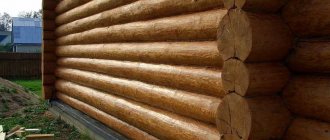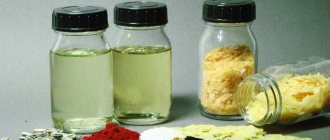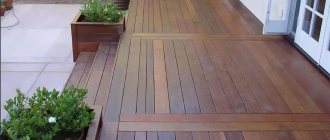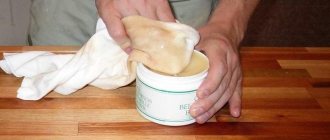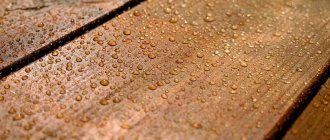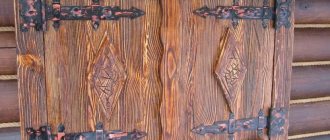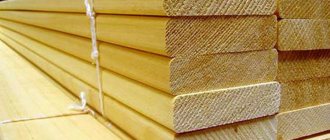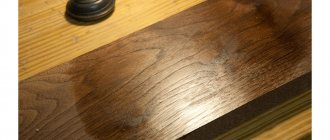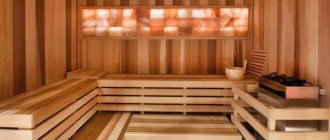Oil is an ideal assistant in the protective and decorative treatment of wood. It is used for finishing floors and terraces, walls and facades, garden and room furniture, saunas and baths. It tints and colors wood, provides protection from ultraviolet radiation and moisture, fungus and mold.
To preserve the natural beauty and warmth of living wood for a long time, you need professional materials. We reviewed 10 manufacturers, among which you will surely find the best wood oil for interior or exterior use specifically for your needs.
The compositions listed in the article effectively care for and protect any untreated wooden surface for a long period of time.
Borma Wachs (Italy)
The Italian company Borma Wachs has been producing professional wood coatings for almost 100 years. The line includes traditional topcoats based on natural oils with a minimal content of volatile organic substances and products completely without them - VOC FREE. The range includes oils for interiors and exteriors, combining aesthetics, resistance and durability with ease of application and maintenance:
- colorless and white parquet oils with resins and hard waxes for finishing;
- universal primer oils for tinting floors and walls, furniture and doors, stairs and ceilings in natural colors;
- finishing materials for countertops and kitchen utensils, children's furniture and toys;
- glazing compounds for facades, gazebos and products for heat-treated wood;
- clear and colored transparent terrace oils and coatings for garden furniture;
- high-hardness oils and waxes for restoration work and processing of antique furniture.
| Product/Features | Purpose | Consumption 1 l/m2 | Drying, 1 sheet/hour | Coating | Smell |
| Grundierol Color Oil | impregnation/priming | 8-12 | 6-8 | colored matte, 18 basic shades | soft |
| Hardwax Parquet Oil | finishing composition for parquet | 10-12 | 8-12 | colorless matte, semi-matte and glossy | soft |
| Holzwachs Lasur | glaze with UV filters and antiseptics for facades | 8-12 | 8 | transparent color, 16 shades | characteristic |
| Terrace Oil | oil with UV filters and antiseptics for terraces | 12-16 | 10-12 | transparent satin, 12 shades | characteristic |
| Sauna Oil | composition for floors and cladding in the sauna and treatment in 1 layer | 8-16 | 24-48 | colorless matte | No |
Saicos (Germany)
German manufacturer of coatings for wooden surfaces. The range includes oil impregnations and finishing coatings based on natural oils: sow thistle, soybean, tung, sunflower and thistle, waxes and safe dyes. The compositions are suitable for different types of wood, including exotic high-density and heat-treated ones. The best wood oil for interior work among the Saicos range is undoubtedly Premium Hartwachsöl, which has a high-class fire hazard certificate KM1.
The assortment includes colorless, colored transparent and opaque products for processing:
- wooden floors - parquet, solid wood, cork;
- furniture, ceilings and walls, slabs, heavily loaded work surfaces and countertops;
- facades and fences, window frames, terraces and street furniture.
The company's product range also includes a whole series of oil additives: anti-slip, fire-resistant, to speed up drying and against fading, as well as compositions with decorative effects of “metallic” and aged wood.
| Product/Features | Area of use | Consumption 1 l/m2 | Drying, 1 sheet/hour | Coating | Smell |
| Oil-Grundierung | oil primer for application in 1 layer | 60 | 8-10 | colored matte, 15 shades | weak |
| Premium Hartwachsol | floor covering | 13,5 | 2-5 | colored transparent and opaque, matte and glossy, 8 shades | weak |
| Holzlasur | glaze with antiseptics for facades and garden furniture | 13 | 10 | colored silky matte, 16 shades | weak |
| Haus & Garten-Farbe | paint for facades and interior works | 17 | 8 | opaque silky matte, 23 colors | weak |
| Holz-Spezialol | oil with UV-resistant pigments for terraces | 14 | 8 | transparent silky matte, 7 shades | weak |
Everything has already been invented before us: the perfect mix of oils
In their pure form, oils for wood processing, even natural ones, are rarely used. To improve their quality:
- heated - natural drying oil is obtained from linseed oil in this way - it is absorbed better and faster, becomes stronger;
- mixed with wax - for better water-repellent effect and shine;
- add turpentine, solvent, even tar.
But then, is it worth taking natural oils for work and then diluting them with chemicals, if ready-made formulations with the required characteristics are available for sale?
In the well-known brands G-Nature and Osmo, manufacturers use synthetic additives in strictly controlled proportions and mix natural oils so that the resulting mix reveals the benefits of all ingredients. The single composition acquires improved characteristics.
Biofa (Germany)
A German company that has been producing products for the protection and decorative treatment of wooden surfaces for almost 40 years. The composition includes linseed, wood and castor oils, soft and hard beeswax and carnauba wax, paraffin and rosin. This allows the materials to penetrate deeply into the wood structure, increasing the gloss, hardness and elasticity of the coating.
In assortment:
- solid oils for floors and furniture, work surfaces;
- universal solid oils for ceilings and walls, floor coverings, stairs and doors;
- oils for terraces and vertical outdoor structures - pergolas, gazebos, fences, facades.
The range for the interior is much wider than for the street. This way, when choosing the best wood oil for interior work, you can compare more options to find the best solution for all your requirements.
The range includes products for light wood, water-based compounds, as well as colored liquid or solid wax for rubbing sauna surfaces. Colorless compositions are tinted in different shades.
| Product/Features | Application | Consumption 1 l/m2 | Drying, 1 sheet/hour | Coating | Smell |
| 2044 | universal composition for priming and finishing | 10 | 16-24 | colorless, silky matte | soft |
| 9062 | for flooring and stairs | 15 | 16-24 | colorless matte | soft |
| 2043M | protective oil with antiseptics for facades | 15 | 16-24 | colorless matte | soft |
| 3753 | composition with antiseptics for terraces | 15 | 6-8 | transparent semi-gloss | weak |
Pros and cons of oil painting
Painting wood with oil is worth it because of a number of advantages:
- Protection from water and dirt. Any oil composition forms a moisture-proof film - this is a natural property of every fat. Dirt and dust, in turn, “slide off” and do not penetrate deep into the wood.
- Health safety. Almost all types of oils (excluding mineral, technical and combined) have a natural base and do not harm human health. There are no toxic components in them.
- Pest protection. Natural wood oil perfectly protects the surface from mold and fungi. Also, antiseptic properties prevent the appearance of insects.
- Elasticity. Oil impregnation or paint makes the wood more flexible. As a result, the walls do not deform under the influence of time and are less likely to dry out and crack.
- Improved appearance. Oil painting ennobles the wood, “highlights” its texture and preserves its natural shade (if there is no toner in the composition). The surface becomes shiny and attractive.
But even natural wood oil has its drawbacks. These include:
- Fragility. Wood needs to be treated with enviable regularity - every six months or even more often.
- Vulnerability to fats. Because of the protective layer, grease does not penetrate into the wood, but very noticeable stains remain on the surface. They can only be removed by re-painting. For kitchens this problem is especially relevant.
Rustins (UK)
The British brand has been producing materials for the protection and decorative processing of wood for about 90 years. It was he who brought Danish oil to the market - a mixture of natural ingredients for coating indoor and outdoor surfaces. The company's products are aimed at connoisseurs of environmental friendliness. The line contains completely herbal formulations without chemical additives.
The main products are acrylic, polyurethane varnishes and stains for tinting before treatment with oils. The brand’s selection of oils themselves is as follows:
- teak and Danish - mixtures based on linseed and tung oils for furniture, countertops, toys and outdoor work;
- pure tung and linseed oils without solvents;
- coverings for floors and work surfaces;
- composition for facades, terraces and decking near outdoor swimming pools.
The manufacturer does not add wax to the materials. For best coating results, it is recommended to apply three layers.
| Product/Features | Purpose | Consumption 1 l/m2 | Drying | Coating | Smell |
| 1 word/hour | |||||
| Danish Oil | the best wood oil from the brand's products for interiors and outdoor surfaces, except floors and terraces | 12-14 | 4-6 | colorless, semi-matte | soft, oily |
| Floor Oil | for floors | 12-14 | 6-8 | colorless, glossy | weak, white spirit |
| Decking Oil (plain and anti-slip) | oils with biocides and UV filters for decking | 12 | 6-8 | colorless and colored transparent, semi-matte | weak, white spirit |
| Worktop Oil (water based) | for kitchen worktops | 12-14 | 24 | colorless, semi-glossy | soft, oily |
| Exterior Wood Oil | for outdoor use | 13 | 2-3 | colorless, semi-matte | weak, white spirit |
What is wood oil and why is it used?
Wood oils are special liquid impregnations, the basis for which is a certain type of oil (linseed, tar, tung, etc.). The composition can be different - from one-component (just fat) to complex, with various additives to enhance characteristics.
This oil is used to protect wood from biological and chemical threats. Basic properties:
- waterproof;
- protection against bacteria and other microorganisms;
- deep penetration into wood;
- decorative finishing of buildings (some types).
This preparation is used not only to treat the walls of houses; oil is often used on wood and furniture. In such cases, it is usually mixed with a solvent so that the product penetrates deeply into the material without forming a film on the surface of the product. Oil for wooden furniture is used if it is at least partially made of wood. Soft and leather parts are not treated.
Currently, mixed oil is used to coat wooden products - not pure fat, but a multicomponent composition with protective additives. Mixtures with wax are also sold - they serve to create a dense layer on the surface of the wood.
Rubio Monocoat (Belgium)
Belgian manufacturer offering 100% natural wood coatings. Their key advantages are composition and economical consumption. Products are applied in one layer, which is sufficient for long-lasting protection. A liter of composition is enough to treat 50 m2. The materials are based on natural and modified linseed oil and beeswax. There are no organic volatiles.
There are three products on the Russian market for interiors and surfaces used outdoors. They are suitable for all types of wood and structures. The palette includes over 40 shades for interior coatings and 28 colors for exterior use.
In addition, the company's assortment includes products for wooden siding and terraces. It involves processing in two steps - first, a colored primer with UV protection is applied, then a layer of oil.
| Product/Features | Purpose | Consumption 1 l/m2 | Drying, 1 sheet/hour | Coating | Smell |
| Oil Plus | indoor use | up to 50 | up to 21 days to gain strength | colored transparent and opaque, matte | No |
| Oil Plus 2C (two-component with drying accelerator) | indoor use, tropical wood | up to 50 | up to 7 days to gain strength | colored opaque and transparent, matte | No |
| Hybrid Wood Protector | outdoor use | up to 30 | 24-36 | colorless and colored, matte | No |
Benefits of oils
Construction stores offer a huge number of protective compounds for wood - oils, stains, varnishes, and waxes.
The most popular and effective for impregnating wooden surfaces are protective oil and wax. They have powerful waterproofing characteristics, while being completely safe and environmentally friendly.
Oils have the following benefits:
- Contains only environmentally friendly components;
- Provide reliable closure of small wood pores;
- They have high water-repellent and wear-resistant properties;
- Give wooden surfaces an attractive appearance;
- Increases the service life of wood;
- Applies well and recovers quickly;
- Do not peel, do not peel, do not deform;
- Do not change the natural color of the wood;
- They are well cleaned from contaminants;
- They have good value for money.
Despite the obvious advantages, oil impregnations have some disadvantages. Thus, oiled wooden surfaces require more attention than varnished bases. Every 4 months they need to be coated with a fresh layer of oil.
Oil treatment does not prevent the appearance of greasy stains, which are difficult to remove with improvised means.
Tikkurila (Finland)
A Finnish company that entered the market more than 150 years ago with the production of linseed oil for technical purposes. This is the first company to introduce a point-of-sale tinting system that allows you to get the color you want right in the store. The brand focuses on paints and varnishes. There is less choice of oils. The compositions are based on linseed and tall oils, waxes and additives that protect surfaces from fungus and mold, ultraviolet radiation, and algae formation.
In the company's line-up:
- antiseptic glazes for facades, open terraces, windows and doors, street furniture;
- products for surfaces in baths and saunas.
The company does not have oil-based coatings for interior work in residential premises.
The choice of oil coatings for outdoor use is wider, so when choosing the best wood oil for outdoor use, pay attention to the company’s product range. Valtti products are tinted in 40 shades, Supi in 36 glaze colors.
| Product/Features | Purpose | Consumption 1 l/m2 | Drying, 1 sheet/hour | Coating | Smell |
| Valtti Pro | heavy-duty glaze with UV filters for facades | 5-14 | 12 | glossy | characteristic, white spirit |
| Valtti Expert Akva | water glaze for exterior use | 5-10 | 2 | matte | weak |
| Terrace Oil | for terraces and outdoor furniture | 5-7 | 12 | matte | characteristic, white spirit |
| Valtti Puuöljy Akva | water-borne oil for garden furniture, docks, terraces | 5-15 | 4 | matte | weak |
| Supi Lattiaöljy | water-based oil for saunas and baths | 8-15 | 48 | transparent, matte | weak |
Oil impregnation for wood processing at home.
Let's look at this process using linseed oil as an example, as it is the cheapest and most accessible to the average craftsman. To work you will need a small list of useful things:
- natural hair brush, foam sponge, soft rag, rags;
- oil, a stick for stirring it;
- construction hair dryer, metal brush - to remove old coating;
- sandpaper to bring the surface to a perfectly smooth state;
- broom for removing dust from the surface;
- gloves to avoid getting dirty.
Impregnation technologies.
There are different ways to oil wood. Some people prefer smearing and further rubbing, while others prefer soaking. True, the second method is suitable only for small objects - decorative dishes, figurines. The dish, by the way, can be used (as a container for bread, salt/sugar, fruit) because it is not at all afraid of water.
Preliminary stage.
An important stage of work before impregnation will be the preliminary preparation of external/internal surfaces. For boiling, you will need to thoroughly sand the dishes or figurines . They are supposed to be freshly carved from wood and not covered with anything on top. Otherwise, you will have to remove both paint and varnish, and this is a very tedious task.
For large areas (walls, floor, ceiling) you will have to do much more:
- Rip off the old coating. This includes varnish and paint. Use a wire brush or spatula for cleaning. If the paint does not want to come off, heat it with a hair dryer. When it bubbles, lift the layer with a spatula and remove.
- Sand the surface. Use two types of sandpaper for this – coarse and fine. You can stop cleaning when you feel a smooth surface without flaws under your hand.
- Remove dust. Brush it off with a soft (Vietnamese) broom or use a regular rag. There should be no dust remaining on the surface before oil impregnation.
Coating.
The easiest way to protect wood from moisture and rot is to oil it. It's best to do this with a rag. But you can also use a brush with natural bristles. This is relevant for small areas (platbands). Impregnate internal/external walls, ceiling or floor with a soft cloth soaked in oil. This is done as follows:
- Stir the product and pour some into a separate container.
- Dampen the rag and start soaking. Apply the composition along the fibers.
- Leave the oil for 15 - 20 minutes. Then remove the residue with a rag.
- Allow the surface to dry, then repeat the treatment.
Soaking.
This method is used for small products. Pour oil into a container and place the pre-cleaned wooden product in it. The holding period is not limited. Ideally, you need to hold a plate, figurine, knife or gun handle until air bubbles stop escaping from the wood.
After this, take out the item and place it on a table covered with clean paper, tilted, so that excess oil drains off. Then take a rag and polish. Pure linseed oil without additives takes a long time to dry - up to 3 weeks. This has its own advantage - the depth of such impregnation is great, and the tree receives excellent protection from moisture, rot, and mold. If you can't wait to see the finished product, add beeswax to the linseed oil. This will significantly speed up the process.
Recipe for oil/wax composition based on linseed oil (suitable for both external and internal surfaces):
- Heat the oil until smoking.
- Pour grated wax into it.
- Stir. When the wax dissolves, pour the mixture into a jar.
- To give the mixture a pleasant aroma, add a few drops of juniper oil.
Gnature (Germany)
Another German company specializing in natural materials for the protective treatment of wood surfaces. The products contain natural ingredients: linseed, castor, safflower and wood oils, rosin, hard and soft waxes, kaolin, thermally treated resins.
The assortment includes protective primer oils, glazing and covering materials for:
- wooden floors, parquet, cork and stairs;
- countertops and furniture (with a high wax content);
- walls and ceilings;
- terraces and decking;
- facades, fences, doors and windows.
The coatings are colorless, tinted according to the catalogue. The line contains organic and completely natural products with zero VOC content. Thanks to a specially selected composition, facade paints are resistant to fading: the company guarantees color retention after Fassadenöl treatment for 10 years.
| Product/Features | Usage | Consumption 1 l/m2 | Drying, 1 sheet/hour | Coating | Smell |
| Hartwachsol | wear-resistant floor oil | 16-20 | 12-16 | matte | light oily |
| Bienenwachslasur | water glaze for walls in rooms | 13-17 | 12-16 | matte shine | No |
| Mobelöl | for furniture and application in 1 layer | 40-50 | 16-24 | silky matte or silky | practically absent |
| Terrassenol | with UV filters for decking boards | 16-20 | 16-24 | matte shine | easy |
| Fassadenol | with UV and bioprotection for facades | 18-Oct | 16-24 | matte | easy |
Pinotex (Netherlands)
A trademark of the Akzo Nobel concern, which produces wood-protective products and focuses on materials that prevent damage by fungus and algae, blue stains and mold, destruction from ultraviolet radiation and moisture. The company's line includes 16 products. The main place is occupied by hybrid-based glazes, solvent-soluble and water-based impregnations, interior water-based, heat-resistant and weather-resistant, yacht varnish.
Oil with a wax additive for treating wooden surfaces is represented by one product. It is intended for outdoor use, protects wood for up to 2 years, is available in a ready-made teak color and can be tinted in 50 colors according to the company’s fan pattern. It is recommended to apply in three layers.
| Product/Features | Application area | Consumption 1 l/m2 | Drying, 1 sheet/hour | Coating | Smell |
| Wood&Terrace Oil | for terraces, garden furniture, windows and doors, gazebos and stairs | up to 20 | 12 | matte | characteristic, white spirit |
How to properly treat a log house with oil impregnation
The oil coating is applied to the frame after shrinkage, the work is carried out in the warm season and in dry weather, the best result is achieved when the wood is impregnated with a humidity of up to 20%. External protection will reliably serve for 2-3 years, and then the operation is repeated. The process of treating a wooden frame with protective oil includes the following operations:
- After shrinkage of the frame, the walls of the building are sanded; when re-applying, the surface is cleaned of the old layer, sanding dust is removed, and the surface is wiped with white spirit;
- Before use, the oil composition is heated to a temperature of 40-50 degrees, applied to the surface along the fibers with a hard brush with natural bristles, after 15-30 minutes, everything that has not been absorbed is removed with a soft rag, the polymerization period depends on the impregnation used and can range from 7 up to 14 days;
- A new layer is applied after polymerization is completed, a total of 3-4 layers are applied, before applying the next layer, the surface is subjected to soft grinding.
Advice from the experts. As the last – finishing layer, it is recommended to use oil wax; you can prepare the composition yourself: add grated beeswax to linseed oil heated in a water bath to 60-70 degrees, and bring the mass to a homogeneous consistency. The resulting mixture has increased moisture-protective properties; after application, it is polished, gives the surface shine and effectively highlights the structure of the wood; scratches and microcracks are eliminated using wax. The composition is wear-resistant and is used for interior decoration, verandas, floors and stairs.
Remmers (Germany)
A German brand with a large product portfolio, which includes compositions for the protection, finishing and restoration of wood. These are impregnations and primers, stains, varnishes and paints, glazes and oils, care products for treated surfaces. The company offers materials for all types of wood and bamboo, professional premium products that can be used as a primer, intermediate and finishing coat.
Products include coatings for:
- facades, garden furniture and terraces;
- parquet and stairs;
- windows and doors;
- furniture and children's toys;
- baths and saunas;
- furniture, floors, stairs.
The line also includes universal azure oils from the ECO series. They can be used in both interior and facade work.
| Product/Features | Usage | Consumption 1 l/m2 | Drying, 1 sheet/hour | Coating | Smell |
| Ol-Dauerschutz-Lasur (eso) | interiors and wood outdoors | about 16 | 8 | matte | weak |
| Hartwachs-Ol (eso) | wooden floors, cork and stairs | 20-25 | 12-16 | matte | weak |
| Wohnraum-Lasur | furniture, walls and ceilings, toys | 10 | 2-5 | silky matte | easy |
| Pflege-Ol | decks, decking and garden furniture, including tropical hardwoods | 14-16 | 12 | glaze matte | characteristic |
Osmo (Germany)
German brand with 140 years of history. The company produces professional coatings and the wood itself, so it knows exactly what treatment and protection should be in different climatic conditions. The products contain a combination of natural sunflower, soybean and thistle oils, hard carnauba and candelilla wax, and paraffin.
The line includes water-based and solvent-soluble materials. However, the latter use a dearomatized solvent, so upon application there is only a slight smell of vegetable oil. All products are economical. A liter is enough to treat 24 m2 in one layer. A closed jar can be stored for 5 years and, if necessary, the coating can be renewed without prior sanding.
The assortment includes colorless, glazing and covering compositions for:
- wooden floors, including in wet rooms;
- furniture, countertops, toys, walls and ceilings, doors and windows;
- facades, wooden street structures;
- open terraces, stairs and pool sides.
The company offers a wide range of products designed specifically for highly targeted, specific tasks. This allows you to find the best oil for light and dark wood, tropical high-density wood, as well as coatings with silver and gold effects, accelerated drying and anti-slip additives.
| Product/Features | Usage | Consumption 1 l/m2 | Drying, 1 sheet/hour | Coating | Smell |
| Hartwachs-Öl Original | branded floor oil | 24 | 12 | colorless matte, semi-matte, glossy, silky matte | weak, oily |
| Dekorwachs (transparent and intense color) | interior from floor tinting to toys | 24 | 12 | silky matte and silky glossy, 24 colors | light, oily |
| Holzschutz Öl-Lasur | 2-in-1 azure primer, any outdoor surfaces | 26 | 4-6 | matte | weak, oily |
| Terrassen-Öle | for decking boards | 24 | 12 | silky matte | light, oily |
| UV-Schutz-Öl Farbig | with UV protection for facades | 18 | 10-12 | transparent, with natural shades | weak, oily |
Coconut oil
Exotic coconut oil is unusual for Russian people for wood processing, but it’s worth taking a closer look at. If only because it has a pleasant, tasty smell, gives the product a strong shine and, judging by reviews, practically does not go rancid, so coconut oil can be recommended primarily for kitchen utensils.
Do you want to get rid of the smell of linseed oil after impregnating wood with it? Treat the product with another layer of coconut oil.
Whether the oil is suitable for processing any wood is unknown. The practice of its use is still small, not least because it is very difficult to find coconut oil for wood on sale.
Coconut oil can be used to treat wood
conclusions
In the products of each manufacturer you can find compositions that will protect, decorate or renew surfaces in the home and outdoors. We present the final table of manufacturers, where you will find information on the average consumption of products, price, coating characteristics and the presence of wax in the composition.
| Brand/Features | Ruler | Average consumption, m2 | Price per liter, rub. | Coating | Wax included |
| Borma Wachs | wide | 8-16 | ≈ 2000 | colored and colorless, up to 18 colors | There is |
| Saicos | wide | 15 | from 700 to 3000 | colorless and colored, up to 23 colors | There is |
| Biofa | wide for interior | 10-15 | from 2000 to 3500 | colorless base, tinted | There is |
| Rustins | narrow | 12-14, application in 3 layers | from 2500 | colorless and three natural shades | No |
| Rubio Monocoat | three products | 30-50, treatment in 1 layer | from 8000 | colorless and colored, from 40 colors | There is |
| Tikkurila | wide for outdoor use | 7-10 | up to 1300 | colorless base, up to 40 shades | No |
| Gnature | wide | 15-20 | ≈ 2000 for 0.75 l | colorless, tinted | There is |
| Pinotex | one product | 20, processing in 3 layers | ≈ 2300 | teak, tinted in 50 shades | wax additive |
| Remmers | wide | 15 | from 1500 to 3000 | colorless and colored in natural shades | There is |
| Osmo | wide | 24 | from 3700 | clear and colored, 24 ready-made colors and tinting in 2000 shades | There is |
Please note that there are products that can be used for different purposes - for tinting, priming and finishing. This allows you to save on surface preparation and reduce processing time.
Some companies pay more attention to protection, others to the decorative effect, and still others try to satisfy all needs with one product. When choosing the best oil for wood, you need to take into account the composition, decorative capabilities, consumption, price and, of course, the tasks facing you.
Let's sum it up
Concluding our review of the protection of log buildings using oil impregnations, we note that the process of creating such coatings has many nuances that are not voiced in publicly available publications.
But since our company is an official dealer of such companies as Osmo, Teknos, Gnature, Tikkurila, Aquatex and Biofa, all specialists working with impregnations regularly attend information and qualification seminars, and therefore all our works are reference samples in this field protection technologies.
accepts orders for finishing, repairs and special processing of log houses or beams, including all types of protection using oil impregnations. The work is carried out in Moscow and the Moscow region. You can clarify the details of cooperation, as well as call a specialist to determine the exact scope of work, by contacting us by phone numbers published in the “Contacts” section.
Calculate the cost of painting and insulating your home right now
